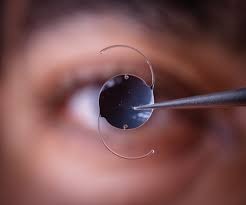For individuals challenged by vision problems like cataracts or myopia, the quest for clear sight often leads to exploring various options for vision correction. Advances in medical technology have forged pathways to innovative solutions, and one such remarkable development is the intraocular lens (IOL), a permanent fixture for improving eyesight without the disadvantages of glasses or temporary contacts.
Understanding Intraocular Lenses
At the heart of this medical triumph is the IOL, a prosthetic device implanted into the eye to replace or enhance the existing lens. This procedure has become a cornerstone in the field of ophthalmology, addressing a range of refractive errors with commendable precision and success rates. IOLs offer patients the potential to regain the clarity and quality of vision that may have been compromised due to age or specific ocular conditions.
The Evolution of the Intraocular Lens
Historically, the concept of IOLs dates back several decades; however, its refinement and widespread adoption have occurred mainly in the past few years. Early iterations of these lenses faced significant challenges, but today’s IOLs benefit from biocompatible materials and cutting-edge designs, ensuring a high degree of patient compatibility and satisfaction.
Types of Intraocular Lenses
The world of IOLs presents a variety of choices tailored to the diverse needs of patients. Monofocal IOLs, delivering a fixed focus at a single distance, have been commonly utilised for years. More recently, advancements have led to the introduction of multifocal and accommodative IOLs, designed to improve vision at various distances, thus elevating the level of functional eyesight for recipients.
Who Benefits from Intraocular Lenses?
Individuals diagnosed with conditions that affect the lens of the eye, such as cataracts, are prime candidates for IOLs. Furthermore, patients seeking alternatives to refractive lens exchange procedures or those unsuitable for laser vision correction may benefit profoundly from the installation of an intraocular lens.
The Procedure: What to Expect
The surgical process of inserting an IOL is performed by a qualified ophthalmologist. It involves a small incision, removal of the affected natural lens, and insertion of the IOL. Conducted under local anaesthesia, the procedure typically takes less than an hour and is usually pain-free, which contributes to its growing acceptance among patients with visual impairments.
Post-Operative Care and Recovery
Recovery from IOL surgery demands minimal downtime, with many individuals returning to their routine activities soon after the operation. Physicians may prescribe eye drops to prevent infection and inflammation, as well as advise on protective measures to ensure optimal healing.
The Long-Term Benefits of IOLs
One of the most significant benefits of IOLs is the permanency of the solution they offer. Unlike contact lenses or glasses, which require regular maintenance and replacements, IOLs are designed to last the lifetime of the recipient, leading to long-term cost savings and convenience.
Improvements in the Quality of Life
The impact of IOLs on one’s quality of life can be transformative. They restore not only visual acuity but also the ability to engage in activities that poor vision might have previously hindered, from driving to reading to experiencing the vivid details of the world around us.
READ MORE : Why Rodents Are a Year-Round Problem in Las Vegas
Visual Independence
For many, the appeal of IOLs lies in the independence from visual aids. The freedom from glasses and contact lenses brings a new level of ease and spontaneity to daily life, underscoring the profound personal value of this medical advancement.
Potential Risks and Considerations
As with any surgical intervention, IOL implantation carries potential risks, such as postoperative infection, inflammation, or lens dislocation. Selecting an experienced eye surgeon and following all recommended pre- and post-operative care can mitigate these risks significantly.
Is an Intraocular Lens Right for You?
Deciding whether to pursue an IOL implant is a decision that should be made in consultation with a healthcare professional. Factors such as the individual’s general health, the severity of their vision impairment, and lifestyle will all play a role in determining the suitability and timing of this procedure.
Choosing the Right Surgeon
When considering IOL implantation, selecting a skilled and reputable ophthalmologist is paramount. Candidates should seek out specialists who have substantial experience in implanting IOLs, and who can provide comprehensive support throughout the evaluation, surgery, and recovery stages.
Embracing Technological Breakthroughs in Ophthalmology
The advent of the intraocular lens represents a milestone in eye care, bringing about a world where diminished vision can be effectively and enduringly corrected. Through ongoing research and development, types and techniques of IOL implantation will continue to evolve, further enhancing the safety, effectiveness, and accessibility of this life-changing procedure.
Conclusion
Finding a clear solution for improved eyesight no longer needs to be a vision beyond reach. Intraocular lenses provide a potent answer to refractive errors and cataract-related sight issues. The technological sophistication and patient-centric developments of IOLs affirm their position as preferred choices for long-lasting vision correction. For those considering their options, consulting with eye care professionals about the benefits of intraocular lenses could be the first step towards experiencing the world through a new lens—one that offers clarity, freedom, and an enhanced quality of life.
